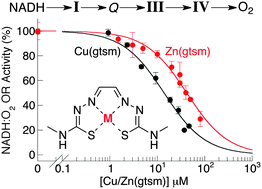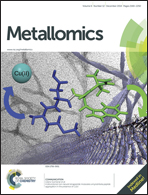Inhibition of respiratory Complex I by copper(ii)-bis(thiosemicarbazonato) complexes†
Abstract
Several copper(II) complexes of bis(thiosemicarbazones) [Cu(btsc)s] show promise as therapeutics for the treatment of neurological diseases, cancers and bacterial infections. These complexes are thought to act primarily as copper ionophores or “copper boosting” agents, whereby the CuII centre is reduced by cytosolic reductants and CuI is released as “free” or “bioavailable” ion. It is then assumed that the dissociated CuI ion is the species responsible for many of the observed biological effects of Cu(btsc)s. We recently showed that Cu(btsc) complexes inhibited NADH dehydrogenases in the bacterial respiratory chain. In this work, we demonstrate that Cu(btsc) complexes also inhibit mitochondrial respiration and that Complex I in the mitochondrial electron transport chain is a specific target of inhibition. However, bioavailable Cu ions do not appear to contribute to the action of Cu(btsc) as a respiratory inhibitor. Instead, an intact Cu(btsc) molecule may bind reversibly and competitively to the site of ubiquinone binding in Complex I. Our results add to the growing body of evidence that the intact complex may be important in the overall cellular activity of Cu(btsc) complexes and further the understanding of their biological effects as a potential therapeutic.


 Please wait while we load your content...
Please wait while we load your content...